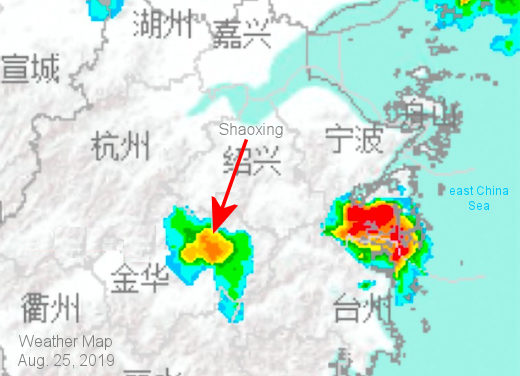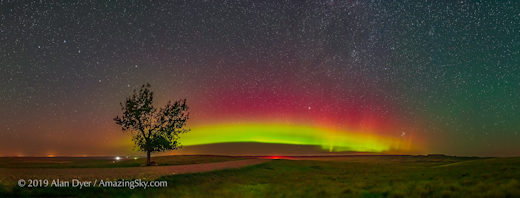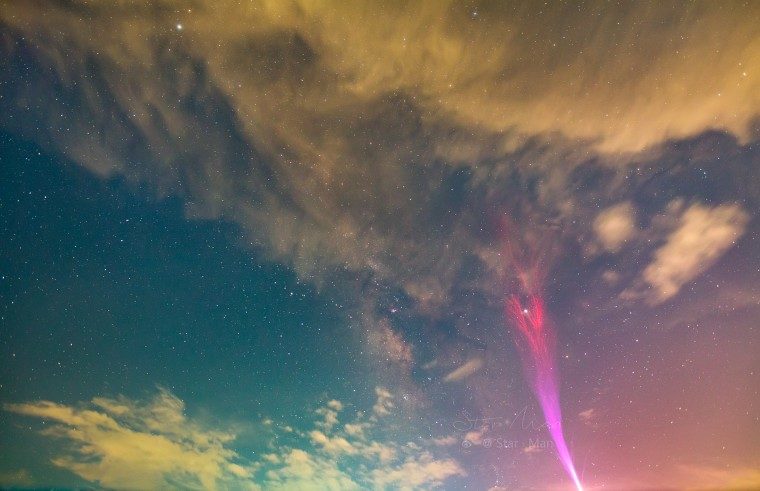You never know what you might see in the wake of a big storm. On Aug. 25th, Chinese astrophotographer Chao Shen of Shaoxing City went outside to photograph the Milky Way.
A typhoon named "White Deer" had passed through the day before, and the storm clouds were parting. "I saw the stars--but that's not all," says Shen. "A Gigantic Jet leaped up right before my eyes!"
Think of them as
sprites on steroids:
Gigantic Jets are lightning-like discharges that spring from the tops of thunderstorms, reaching all the way to the edge of space. They're enormous and powerful.
"Shen definitely caught a Gigantic Jet," confirms Oscar van der Velde of the Lightning Research Group at the Universitat Politècnica de Catalunya. "It looks like
it may have reached as high as 90 km above the ground.""Gigantic Jets are much more rare than sprites," says van der Velde.
"While sprites were discovered in 1989 and have since been photographed by the thousands, it was not until 2001-2002 that Gigantic Jets were first recorded from Puerto Rico and Taiwan." Only dozens of Gigantic Jets have ever been photographed.
Shen says that "the Jet came from a storm about 100 km southwest of me. It was so huge, I was able to see it clearly
despite the distance."

The arrow in this weather map points from Chao Shen's camera toward the jet-producing storm.
Observers of sprites may be wondering if Shen
really saw this jet. The answer is "yes."
Unlike sprites, which flicker so rapidly that they are difficult to see with the unaided eye. Gigantic Jets can lasts for hundreds of milliseconds, long enough for human eyes to register their purple glow.Gigantic jets are part of a growing menagerie of strange forms that appear above intense thunderstorms, including sprites, elves, trolls, and blue jets. Some researchers believe that cosmic rays help trigger these "transient luminous events" by ionizing the air in and around thunderheads. If so, now is a good time to look for Gigantic Jets, because
cosmic rays are nearing a Space Age high. Thank you, Solar Minimum!A CRACK IN EARTH'S MAGNETIC FIELD: There was no geomagnetic storm on Aug. 26th. Auroras appeared anyway. Unexpected by forecasters,
a crack opened in Earth's magnetic field, allowing solar wind into our planet's magnetosphere. Alan Dyer photographed the resulting glow from southern Saskatchewan in the Grasslands National Park:
"It was quite photogenic," says Dyer. "To the naked eye, the display was diffuse and pale, but my camera picked up the colors with no trouble." Auroras like these are called "deep sky auroras" because they require some exposure with a camera for full effect.

© Alan DyerAuroral Arc taken by Alan Dyer on August 26, 2019 @ Grasslands National Park, SK
Photographers, would you like an instant text message when cracks open in Earth's magnetic field? Subscribe to the
Pro Plan of
Spaceweather Alerts. Your phone will tell you when deep sky auroras are waiting outside.



Comment: Wiki details the difference between a blue jet and a gigantic jet: See also: